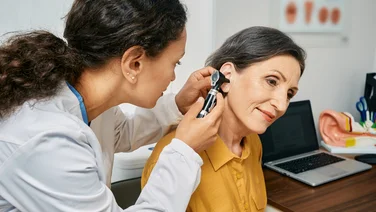If you’ve noticed some difficulties with your hearing, the chances are you’ll benefit from having your hearing tested.
Around 37.5 million adults in the US report they have hearing problems – around 15% of the population. Among people aged 75 and over, half have disabling or severe hearing loss.
However, according to the American Speech-Language-Hearing Association (ASHA), only 20% of adults responding to a poll said they’d had a hearing test in the last five years.
Hearing loss has multiple possible causes, and many of them are treatable.
It’s important to have your hearing loss assessed by a healthcare professional so that the cause is identified and the best course of treatment can be recommend.If you think your hearing test is overdue, or your hearing is gradually getting worse, it’s always worth speaking to a professional. We can connect you with a local audiologist to get you the help you need. Fill in our quick form and we’ll do the rest.
What is a hearing test?
Hearing tests assess how well you can hear, and can identify if you have any hearing loss, the degree of hearing loss, and what’s causing it.
There are different types of hearing loss, and hearing tests can help to determine which type of hearing loss you have.

Some hearing tests for kids might be the same as for adults, while others will be different.
Do I need a hearing test?
It is recommended that adults have a routine hearing test every 10 years until they’re 50, and every three years thereafter.
Many people don’t realize they have hearing loss because it happens gradually and over a long period of time. Often, loved ones notice the signs of hearing loss before you recognize anything is different.
This is why it’s a good idea to attend your scheduled hearing test when it’s due.
You should also consider having a hearing test if you’ve noticed any changes in your hearing as the audiologist could indicate if there is any hearing loss.
- Trouble hearing people speaking, especially in crowded, noisy places
- Having to ask people to repeat themselves or to talk slower
- People’s voices sound muffled
- Having to frequently turn up the volume on the TV or radio
- Struggling to distinguish consonant sounds
- Finding it difficult to hear people while using a phone
- Avoiding social situations or becoming increasingly isolated because you find it hard to keep up with conversations
- Getting tired or stressed, having to focus more while listening
You might feel embarrassed or uncomfortable at the prospect of losing your hearing. But it’s important to remember that the sooner you have your hearing tested and the cause of your hearing loss diagnosed, the more likely it is to be successfully treated and better managed.
What hearing tests will I have?
Your doctor or audiologist will run through your medical history and ask you about your hearing. They will suggest which tests might be useful.
Some hearing aid brands and service providers offer online hearing tests and free hearing tests. These are typically less reliable than standard, in-person hearing tests, which are also more thorough.
It is recommended that you visit your doctor or audiologist to have your hearing tested. Below are some of the most common types of adult hearing tests you might come across:
Hearing screening
This is a very quick, basic test to check how well you hear different sounds. It’s a simple pass-fail test, and if you pass you won’t need to do anything else. If you fail, you should have more tests.
Anyone can have a hearing screening at any age. These are used to check the hearing of newborn babies before they leave the hospital, as well as during hearing tests for kids.
Pure-tone testing
This test involves wearing earphones that play beep sounds into each ear in turn. When you hear a sound through the earphones, you indicate you’ve heard it by either raising your hand or pressing a button.
The sounds are played at different levels of volume and pitch. This helps to find the quietest sound you can hear in each ear at different pitches.
Tuning fork testing
This is a simple test that can quickly signal what type of hearing loss you have. It is also called a Weber hearing test or a Rinne hearing test.
Sensorineural hearing loss occurs as a result of damage to a part of the inner ear, or the auditory nerve that carries sound waves to the brain. Conductive hearing loss occurs when sound waves are blocked from moving through the outer or inner ear, stopping sound from reaching the inner ear.
During a tuning fork hearing test, your audiologist will hold a a tuning fork ( a two-pronged metal tool) behind your ear or on top of your head.
They’ll then strike the tuning fork so it makes a sound. It’s completely painless and takes a few moments.
You then tell the person conducting the test when you hear the sound, whether you hear it at different volumes, and whether you hear it in one ear or both ears.
How you respond when the fork is struck both behind your ear and on your head will help determine whether you have sensorineural or conductive hearing loss, and whether it affects one ear (unilateral) or both ears (bilateral).
Speech reception threshold testing
This test is similar to pure-tone testing, but it uses speech rather than beep sounds. You will wear a pair of headphones and the audiologist will say different words at different volumes. These will then play through the headphones.
When you hear the word, you repeat it. This will help to identify if you have trouble hearing speech, and whether you struggle with particular speech sounds.

You might have speech testing in a noisy environment to identify if hearing speech and conversations is difficult when it’s noisy.
Tympanometry
This is a type of middle ear hearing test, and it’s used to check for any problems with your eardrum.
It involves having a small probe placed into your ear canal. The probe is attached to a device that pushes air into your ear, and your eardrum should move back and forth in response.
The way your eardrum moves is then recorded on a graph, and your audiologist will use the readings to determine if there’s a problem with your eardrum. These include a tear or hole in your eardrum, fluid in your middle ear, a build-up of wax deep in your ear canal, or an infection.
Acoustic reflex measures
This is another type of middle ear hearing test, and this one will look at how your ear responds to very loud sounds.
Inside your ear is a tiny muscle that tightens or contracts when you hear a loud noise., which is an automatic response or reflex. How much this muscle moves in response to noise is called your acoustic reflex.
In an acoustic reflex test, sounds will play through a probe inside your ear. The audiologist will measure how loud a sound is before your acoustic reflex kicks in.
This can help identify how bad your hearing loss is. If you have very severe hearing loss you might not have any acoustic reflex.
Otoacoustic emissions test (OAE test)
The OAE test is used to assess how well your inner ear, or cochlea, works. Like with other hearing tests, a small probe is placed into your ear, and sounds are played through it.
In standard hearing, when you hear a noise your inner ear will produce very quiet sounds back to the middle ear in response to the noise. These are called otoacoustic emissions, or OAEs.
During an OAE test, the probe picks up these emissions when you hear the sounds, and they’re recorded on a monitor.
Hearing loss can be measured according to how loud a sound needs to be for you to hear it. This is known as hearing loss range (decibel hearing loss or dBHL).
If your hearing loss range is greater than 20-40 dBHL – meaning it’s mild to moderate – you won’t produce OAEs.
Auditory brainstem response testing
This kind of test is used to detect problems with the way the inner ear sends signals to the brain and the brain’s response to them. These are normally used to screen for congenital hearing loss in babies when they are born, and are often given to children at school.
What happens after my hearing test?
Whether you one, two, or all of these tests will depend entirely on your individual circumstances.
When you’ve undergone the hearing loss tests you need, your audiologist will look at all the results to get a broad picture of:
- Whether you have hearing loss
- What type of hearing loss you have
- The cause of your hearing loss
- The degree of hearing loss
- Whether one or both of your ears are affected (unilateral or bilateral)
- Whether your hearing loss is likely to be permanent
The test results can also help identify what kind of treatment you are likely to benefit from.
Treatment options will depend on all of these factors, but your preferences will also be taken into account.
The best treatment is often to wear a hearing aid. They work by amplifying sound, making it louder so that you can hear more clearly.
If you are diagnosed with very severe or profound hearing loss, you might be a candidate for a cochlear implant.








